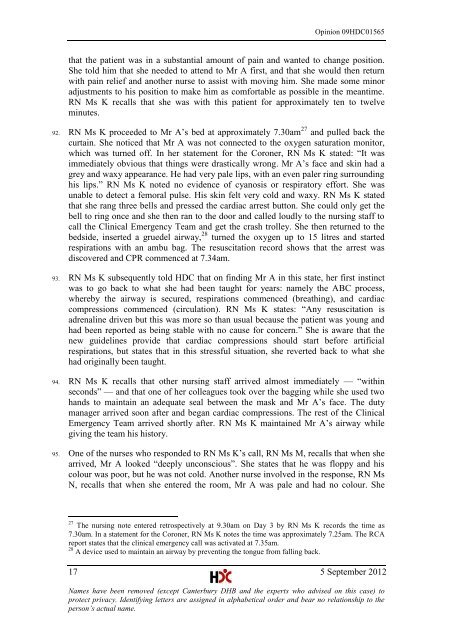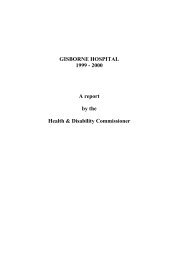09HDC01565 - Health and Disability Commissioner
09HDC01565 - Health and Disability Commissioner
09HDC01565 - Health and Disability Commissioner
You also want an ePaper? Increase the reach of your titles
YUMPU automatically turns print PDFs into web optimized ePapers that Google loves.
Opinion <strong>09HDC01565</strong><br />
that the patient was in a substantial amount of pain <strong>and</strong> wanted to change position.<br />
She told him that she needed to attend to Mr A first, <strong>and</strong> that she would then return<br />
with pain relief <strong>and</strong> another nurse to assist with moving him. She made some minor<br />
adjustments to his position to make him as comfortable as possible in the meantime.<br />
RN Ms K recalls that she was with this patient for approximately ten to twelve<br />
minutes.<br />
92. RN Ms K proceeded to Mr A‘s bed at approximately 7.30am 27 <strong>and</strong> pulled back the<br />
curtain. She noticed that Mr A was not connected to the oxygen saturation monitor,<br />
which was turned off. In her statement for the Coroner, RN Ms K stated: ―It was<br />
immediately obvious that things were drastically wrong. Mr A‘s face <strong>and</strong> skin had a<br />
grey <strong>and</strong> waxy appearance. He had very pale lips, with an even paler ring surrounding<br />
his lips.‖ RN Ms K noted no evidence of cyanosis or respiratory effort. She was<br />
unable to detect a femoral pulse. His skin felt very cold <strong>and</strong> waxy. RN Ms K stated<br />
that she rang three bells <strong>and</strong> pressed the cardiac arrest button. She could only get the<br />
bell to ring once <strong>and</strong> she then ran to the door <strong>and</strong> called loudly to the nursing staff to<br />
call the Clinical Emergency Team <strong>and</strong> get the crash trolley. She then returned to the<br />
bedside, inserted a gruedel airway, 28 turned the oxygen up to 15 litres <strong>and</strong> started<br />
respirations with an ambu bag. The resuscitation record shows that the arrest was<br />
discovered <strong>and</strong> CPR commenced at 7.34am.<br />
93. RN Ms K subsequently told HDC that on finding Mr A in this state, her first instinct<br />
was to go back to what she had been taught for years: namely the ABC process,<br />
whereby the airway is secured, respirations commenced (breathing), <strong>and</strong> cardiac<br />
compressions commenced (circulation). RN Ms K states: ―Any resuscitation is<br />
adrenaline driven but this was more so than usual because the patient was young <strong>and</strong><br />
had been reported as being stable with no cause for concern.‖ She is aware that the<br />
new guidelines provide that cardiac compressions should start before artificial<br />
respirations, but states that in this stressful situation, she reverted back to what she<br />
had originally been taught.<br />
94. RN Ms K recalls that other nursing staff arrived almost immediately — ―within<br />
seconds‖ — <strong>and</strong> that one of her colleagues took over the bagging while she used two<br />
h<strong>and</strong>s to maintain an adequate seal between the mask <strong>and</strong> Mr A‘s face. The duty<br />
manager arrived soon after <strong>and</strong> began cardiac compressions. The rest of the Clinical<br />
Emergency Team arrived shortly after. RN Ms K maintained Mr A‘s airway while<br />
giving the team his history.<br />
95. One of the nurses who responded to RN Ms K‘s call, RN Ms M, recalls that when she<br />
arrived, Mr A looked ―deeply unconscious‖. She states that he was floppy <strong>and</strong> his<br />
colour was poor, but he was not cold. Another nurse involved in the response, RN Ms<br />
N, recalls that when she entered the room, Mr A was pale <strong>and</strong> had no colour. She<br />
27 The nursing note entered retrospectively at 9.30am on Day 3 by RN Ms K records the time as<br />
7.30am. In a statement for the Coroner, RN Ms K notes the time was approximately 7.25am. The RCA<br />
report states that the clinical emergency call was activated at 7.35am.<br />
28 A device used to maintain an airway by preventing the tongue from falling back.<br />
17 5 September 2012<br />
Names have been removed (except Canterbury DHB <strong>and</strong> the experts who advised on this case) to<br />
protect privacy. Identifying letters are assigned in alphabetical order <strong>and</strong> bear no relationship to the<br />
person’s actual name.
















